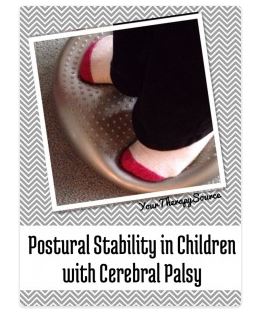Postural Stability and Cerebral Palsy
[Source: Pediatric Physical Therapy via Your Therapy Source]
 Pediatric Physical Therapy published research comparing postural stability during static upright standing between 45 children with cerebral palsy (CP) and 45 age-matched peers with typical development (TD) ages 5-12 years old. A posturography device was used for assessment. Postural stability was evaluated under 4 sensory conditions: eyes open and eyes closed on a firm surface; eyes open and eyes closed on a foam surface.
Pediatric Physical Therapy published research comparing postural stability during static upright standing between 45 children with cerebral palsy (CP) and 45 age-matched peers with typical development (TD) ages 5-12 years old. A posturography device was used for assessment. Postural stability was evaluated under 4 sensory conditions: eyes open and eyes closed on a firm surface; eyes open and eyes closed on a foam surface.
The results indicated the following:
1. Statistically significant differences were obtained between children with spastic diplegic CP and children with TD under all conditions involving visual and somatosensory conflicts
2. no significant differences were found between children with hemiplegic CP and children with TD.
The researchers concluded that children with spastic diplegic CP have increased postural instability under sensory conditions with both visual and somatosensory conflicts.
Reference: Saxena, Shikha MPT; Rao, Bhamini K. MPT, PhD; Kumaran, Senthil MPT. Analysis of Postural Stability in Children With Cerebral Palsy and Children With Typical Development: An Observational Study. Pediatric Physical Therapy Fall 2014 Vol. 26 – Issue 3: p 325-330
Please Support our Contributors and Visit Your Therapy Source and the Your Therapy Source Blog
PediaStaff is Hiring!
All JobsPediaStaff hires pediatric and school-based professionals nationwide for contract assignments of 2 to 12 months. We also help clinics, hospitals, schools, and home health agencies to find and hire these professionals directly. We work with Speech-Language Pathologists, Occupational and Physical Therapists, School Psychologists, and others in pediatric therapy and education.
